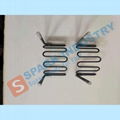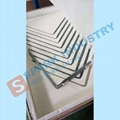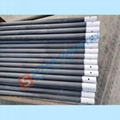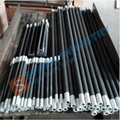| Model: | - |
|---|---|
| Brand: | Spark |
| Origin: | - |
| Category: | Metallurgy , Mining & Energy / Metallurgy & Mining / Non-ferrous Metal Alloy |
| Label: | - |
| Price: |
US $25
/ pc
|
| Min. Order: | 10 pc |
| Live Chat: | Last Online:28 Sep, 2022 |
Heating Elements
MoSi2 is a conductive silicide that is oxidation-resistant because of the formation of stable silica layers on its surfaces at high temperatures.
MoSi2 has been produced as an electric heating element for use in air, at temperatures beyond 1600 °C. A known commercial MoSi2 heating element is cermet, which is made by bonding a mixture of MoSi2 particles together with an aluminosilicate glass phase, usually as 20% of the total volume.
Although top-grade MoSi2 elements can function at temperatures of up to 1800 °C, the material is highly brittle and can suffer severely from creep during use. However, they offer process benefits as they can work at high electrical loads without aging, and do not exhibit increasing electrical resistivity during use. They are oxidation-resistant in air, oxygen, and oxygen-rich atmospheres.
Moreover, they can be used with ammonia, nitrogen, hydrogen, noble gases, and limited vacuum, but operating temperatures and service life may be decreased because of the failure of the protective oxide layer.
MoSi2 elements come as readymade elements and are manufactured as either bent or straight forms, in an extensive range of dimensions. The elements are primarily used in production furnaces and laboratory furnaces in the ceramics, glass, steel, electronics, and heat-treatment sectors.

| Atmosphere | Max. element temperature | |
| MS1700 | MS1800 | |
| Air | 1700℃ | 1800℃ |
| Nitrogen | 1600℃ | 1700℃ |
| Argon, Helium | 1600℃ | 1700℃ |
| Hydrogen | 1100-1450℃ | 1100-1450℃ |
| N2/H2 95/5% | 1250-1600℃ | 1250-1600℃ |
Chemical Properties of Physical Properties of Mosi2 Heating Rod
Oxygen-resistance under high temperature: in oxidizing atmosphere, a layer of compact quartz protective film is formed on the surface of element owing to the high temperature combustion, which prevent Mosi2 from oxidizing more. When the element temperature is higher than 1700 °C, the film becomes melting. It’s not suitable for long time use in the temperature range of 400-700°C, otherwise, the element will be powdering for the strong oxidation under low temperature.
MoSi2 is a conductive silicide that is oxidation-resistant because of the formation of stable silica layers on its surfaces at high temperatures.
MoSi2 has been produced as an electric heating element for use in air, at temperatures beyond 1600 °C. A known commercial MoSi2 heating element is cermet, which is made by bonding a mixture of MoSi2 particles together with an aluminosilicate glass phase, usually as 20% of the total volume.
Although top-grade MoSi2 elements can function at temperatures of up to 1800 °C, the material is highly brittle and can suffer severely from creep during use. However, they offer process benefits as they can work at high electrical loads without aging, and do not exhibit increasing electrical resistivity during use. They are oxidation-resistant in air, oxygen, and oxygen-rich atmospheres.
Moreover, they can be used with ammonia, nitrogen, hydrogen, noble gases, and limited vacuum, but operating temperatures and service life may be decreased because of the failure of the protective oxide layer.
MoSi2 elements come as readymade elements and are manufactured as either bent or straight forms, in an extensive range of dimensions. The elements are primarily used in production furnaces and laboratory furnaces in the ceramics, glass, steel, electronics, and heat-treatment sectors.

| Atmosphere | Max. element temperature | |
| MS1700 | MS1800 | |
| Air | 1700℃ | 1800℃ |
| Nitrogen | 1600℃ | 1700℃ |
| Argon, Helium | 1600℃ | 1700℃ |
| Hydrogen | 1100-1450℃ | 1100-1450℃ |
| N2/H2 95/5% | 1250-1600℃ | 1250-1600℃ |
Chemical Properties of Physical Properties of Mosi2 Heating Rod
Oxygen-resistance under high temperature: in oxidizing atmosphere, a layer of compact quartz protective film is formed on the surface of element owing to the high temperature combustion, which prevent Mosi2 from oxidizing more. When the element temperature is higher than 1700 °C, the film becomes melting. It’s not suitable for long time use in the temperature range of 400-700°C, otherwise, the element will be powdering for the strong oxidation under low temperature.
| Payment Terms: | TT / LC / PayPal |
|---|---|







